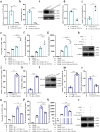Identifying TNFSF4low-MSCs superiorly treating idiopathic pulmonary fibrosis through Tregs differentiation modulation
- PMID: 40254578
- PMCID: PMC12010539
- DOI: 10.1186/s13287-025-04313-6
Identifying TNFSF4low-MSCs superiorly treating idiopathic pulmonary fibrosis through Tregs differentiation modulation
Abstract
Background: Idiopathic pulmonary fibrosis is a progressive lung disorder, presenting clinically with symptoms such as shortness of breath and hypoxemia. Despite its severe prognosis and limited treatment options, the pathogenesis of idiopathic pulmonary fibrosis remains poorly understood. This study aims to investigate the therapeutic potential of mesenchymal stromal cells in treating idiopathic pulmonary fibrosis, focusing on their ability to modulate regulatory T cells through the low tumor necrosis factor superfamily member 4 (TNFSF4) pathway. The goal is to identify mesenchymal stromal cells subtypes with optimal immunomodulatory effects to enhance regulatory T cells functions and ameliorate fibrosis.
Methods: We identified the immune characteristics of idiopathic pulmonary fibrosis by mining and analyzing multiple public datasets and detecting regulatory T cells in the blood and lung tissues of idiopathic pulmonary fibrosis patients. An extensive examination followed, including assessing the impact of mesenchymal stromal cells on regulatory T cells proportions in peripheral blood and lung tissue, and exploring the specific role of TNFSF4 expression in regulatory T cells modulation. Whole-genome sequencing and cluster analysis were used to identify mesenchymal stromal cells subtypes with low TNFSF4 expression.
Results: Mesenchymal stromal cells characterized by TNFSF4 expression (TNFSF4low-MSCs) demonstrated enhanced ability to regulate regulatory T cells subpopulations and exhibited pronounced anti-fibrotic effects in the bleomycin-induced idiopathic pulmonary fibrosis mouse model. These mesenchymal stromal cells increased regulatory T cells proportions, reduced lung fibrosis, and improved survival rates. TNFSF4-tumor necrosis factor receptor superfamily member 4 (TNFRSF4) signaling was identified as a critical pathway influencing regulatory T cells generation and function.
Conclusions: Our findings underscore the pivotal role of TNFSF4 in mesenchymal stromal cells mediated regulatory T cells modulation and highlight the therapeutic potential of selecting mesenchymal stromal cells subtypes based on their TNFSF4 expression for treating idiopathic pulmonary fibrosis. This approach may offer a novel avenue for the development of targeted therapies aimed at modulating immune responses and ameliorating fibrosis in idiopathic pulmonary fibrosis.
Trial registration: Our study involved collecting 10 mL of peripheral blood from idiopathic pulmonary fibrosis patients, and the Medical Ethics Committee of Nanjing Drum Tower Hospital approved our study protocol with the approval number 2023-675-01.
Keywords: Fibrosis therapy; Idiopathic pulmonary fibrosis; Immunomodulation; Mesenchymal stromal cells; Regulatory T cells; TNFSF4.
© 2025. The Author(s).
Conflict of interest statement
Declarations. Ethics approval and consent to participate: Ethnic approval was granted by the Medical Ethics Committees of Nanjing Drum Tower Hospital (Project title: Utilization of Clinical Patient Samples (Tissue/Blood/Body Fluids) and Aborted Fetal Tissue to Extract Stromal Cells for Basic and Clinical Research in Regenerative Medicine and Treatment of Clinical Diseases; Approval No. 2017-161-08; Date of approval: 2017-11-30. Project title: TNFSF4(low)-MSCs Improve IPF by Regulating Tregs Subtypes; Approval No. 2023-675-01; Date of approval: 2023-03-20). All experiments involving mice were approved by the Ethics Committee of Nanjing Drum Tower Hospital (Project title: Research on the Mechanism of MSCs in Treating Pulmonary Fibrosis; Approval No. DWSY-22047178; Date of approval: 2022-04-07). All participants provided written informed consent before enrollment in the study. Consent for publication: Not applicable. Competing interests: The authors declare that they have no competing interest.
Figures






Similar articles
-
Immunomodulation by mesenchymal stem cells in treating human autoimmune disease-associated lung fibrosis.Stem Cell Res Ther. 2016 Apr 23;7(1):63. doi: 10.1186/s13287-016-0319-y. Stem Cell Res Ther. 2016. PMID: 27107963 Free PMC article.
-
Urine-Derived Stem Cells Reverse Bleomycin‑Induced Experimental Pulmonary Fibrosis by Inhibition of the TGF-β1-Smad2/3 Pathway.Cytotherapy. 2024 Oct;26(10):1236-1244. doi: 10.1016/j.jcyt.2024.05.015. Epub 2024 May 17. Cytotherapy. 2024. PMID: 38852093
-
Hypoxia-preconditioned mesenchymal stem cells attenuate bleomycin-induced pulmonary fibrosis.Stem Cell Res Ther. 2015 May 20;6(1):97. doi: 10.1186/s13287-015-0081-6. Stem Cell Res Ther. 2015. PMID: 25986930 Free PMC article.
-
Regulatory Immune Cells in Idiopathic Pulmonary Fibrosis: Friends or Foes?Front Immunol. 2021 Apr 22;12:663203. doi: 10.3389/fimmu.2021.663203. eCollection 2021. Front Immunol. 2021. PMID: 33995390 Free PMC article. Review.
-
Updates on the controversial roles of regulatory lymphoid cells in idiopathic pulmonary fibrosis.Front Immunol. 2024 Sep 25;15:1466901. doi: 10.3389/fimmu.2024.1466901. eCollection 2024. Front Immunol. 2024. PMID: 39386201 Free PMC article. Review.
References
-
- Raghu G, Remy-Jardin M, Myers JL, Richeldi L, Ryerson CJ, Lederer DJ, et al. Diagnosis of idiopathic pulmonary fibrosis. An official ATS/ERS/JRS/ALAT clinical practice guideline. Am J Respir Crit Care Med. 2018;198(5):e44–68. - PubMed
-
- Richeldi L, Collard HR, Jones MG. Idiopathic pulmonary fibrosis. Lancet. 2017;389(10082):1941–52. - PubMed
-
- George PM, Patterson CM, Reed AK, Thillai M. Lung transplantation for idiopathic pulmonary fibrosis. Lancet Respir Med. 2019;7(3):271–82. - PubMed
MeSH terms
Substances
Grants and funding
- No. BK20230141/Natural Science Foundation of Jiangsu Province of China
- No. 82070459/National Natural Science Foundation of China
- No. 82270701/National Natural Science Foundation of China
- No. 82270076/National Natural Science Foundation of China
- No. YKK23108/Nanjing Municipal Health Science and Technology Development Special Fund Project
LinkOut - more resources
Full Text Sources

